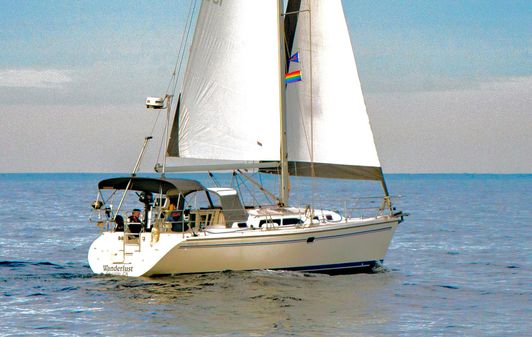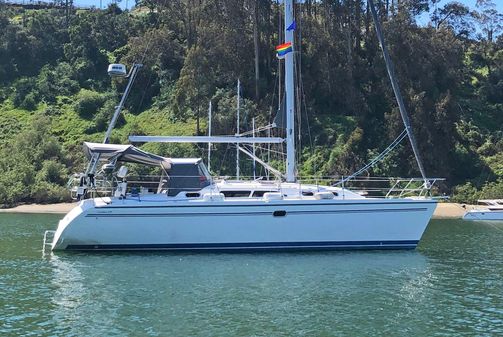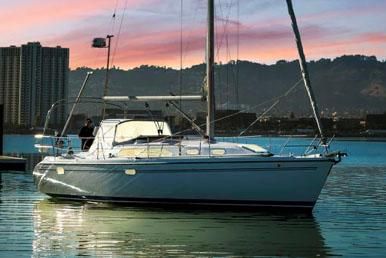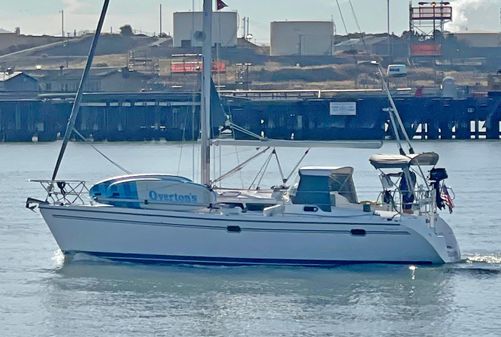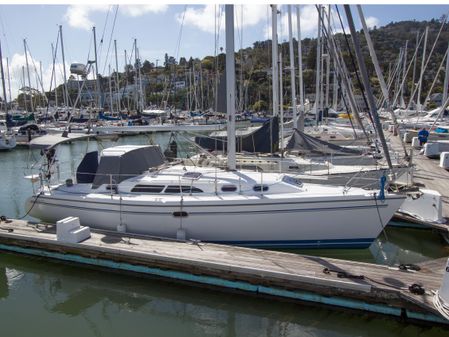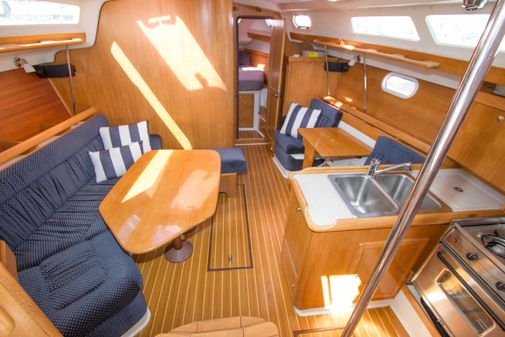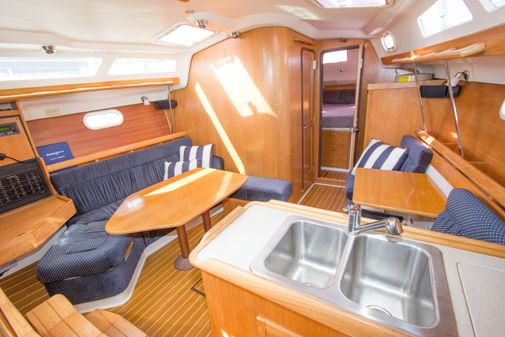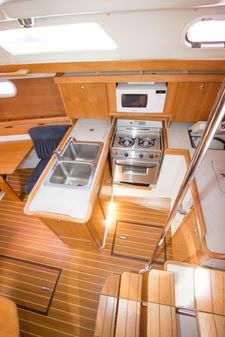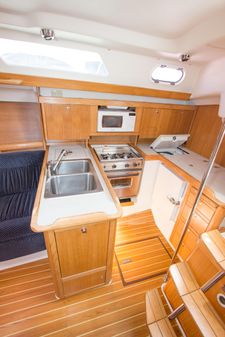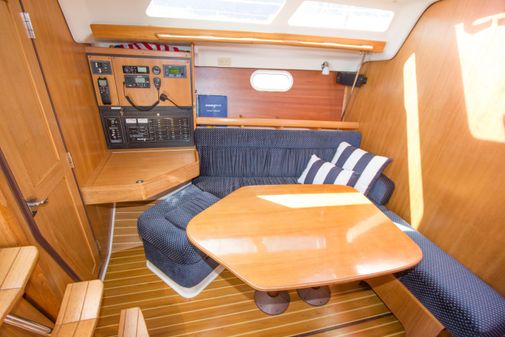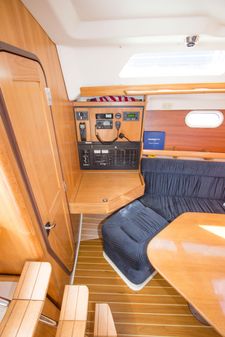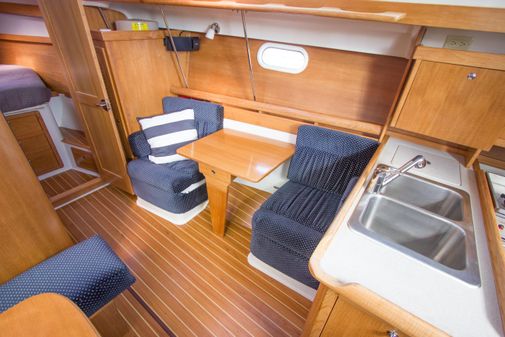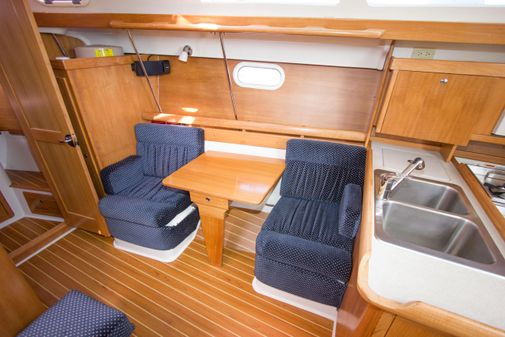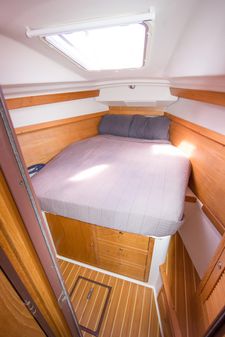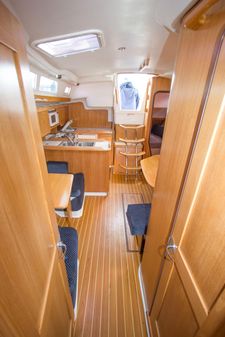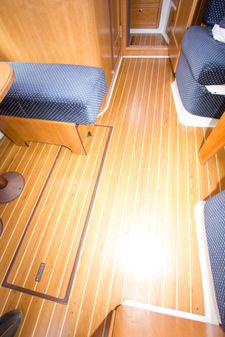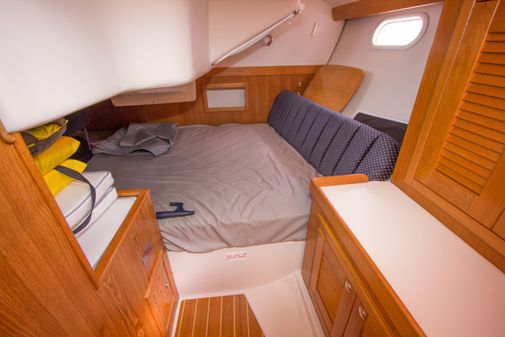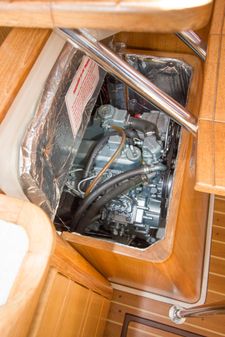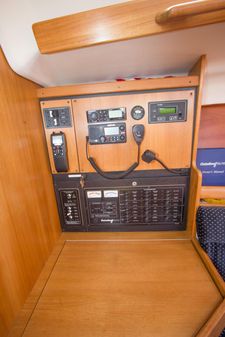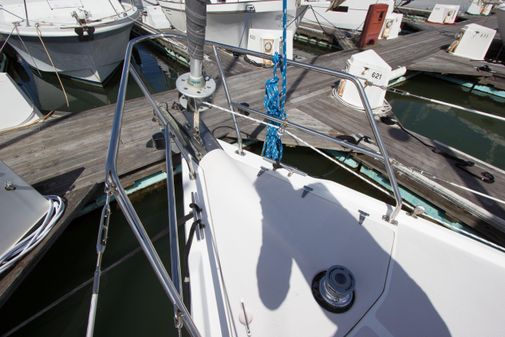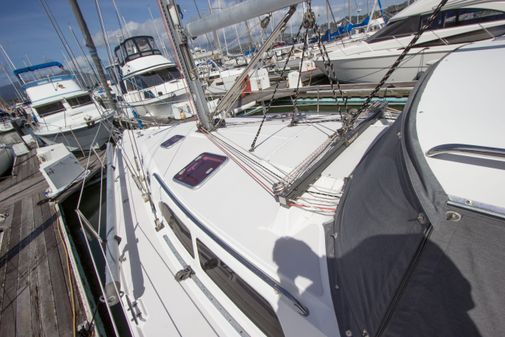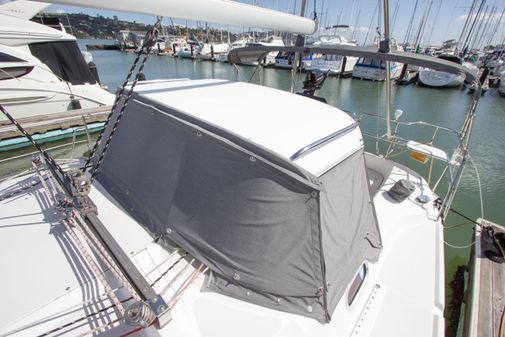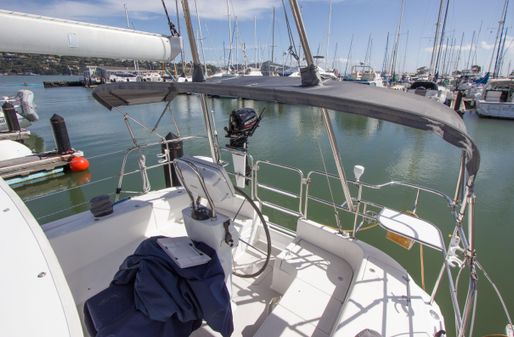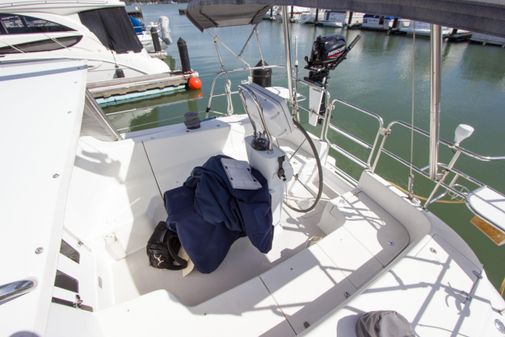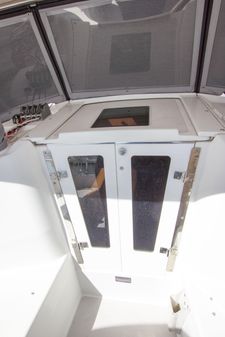Basic Boat Info
Dimensions
Engines / Speed
- Make: Universal
- Model: M-35B
- Fuel: Diesel
- Engine Power: 35hp
- Type: Inboard
- Propeller Type: 3 BladeBronze
- Engine Location: Center
- Drive Type: Direct
- Year: 2003
- Engine Hours: 1,177
Tanks
Other
Contact
Office
100 Bay Street
Sausalito, CA, US, 94965
Tel:415-331-6200
The Company offers the details of this vessel in good faith but cannot guarantee or warrant the accuracy of this information nor warrant the condition of the vessel. A buyer should instruct his agents, or his surveyors, to investigate such details as the buyer desires validated. This vessel is offered subject to prior sale, price change, or withdrawal without notice.
Master stateroom forward with raised double centerline berth, hanging lockers and private entrance to head with separate stall shower. Step aft and there's second door to the head port side with another hanging locker across starboard.
Another step aft to salon with settee and dinette port with two built in seats separated by cocktail table over to port.
Far aft port side is nave station at aft end of settee and guest stateroom with queen size berth set athwartship under the cockpit, centerline companionway up and U-shaped galley starboard.
This from Practical Sailor:
"Though Catalina always has favored the creation of large living spaces, the asymmetrical shape of the main cabin on the 350 carries the concept to a new level. Her 13′ beam is 13″ wider than the 36 MKII. “It has a big-boat galley, big-boat head, and large forward cabin to pamper owners. It is not a conventional design,” Douglas says. “However, we did this without making any significant compromises in living spaces or performance. It has more headroom (6’9″) than you would expect in a conventional 35-footer, but we accomplished that by lowering the cabin sole, because we didn’t want to elevate the cabinsides.”
Step belowdecks and comparisons to other 35-foot production boats become difficult. This boat is all about space. The main cabin measures 9′ 6″ on the centerline from the base of the companionway ladder to the port bulkhead at the head. The cabin at its widest point, measured from the backs of settees, is 10′ 5″. To put that in perspective, a bedroom in an average-sized apartment is 10′ x 12′.
Two hatches on the cabintop and five ports on each side of the cabin and hull add light that increases even more the feeling of spaciousness.
Seating in this cavern is on a settee to port measuring 66″, and another to starboard measuring 73″. The latter can be bisected by a teak-veneered drop-down game table. The dining table, located to port, measures 31″ x 48″ and, with a bench on the centerline, will seat six. It can also be stored and replaced by a smaller “cocktail” table.
The U-shaped galley has room for one person, who will be well-braced in a seaway, and is adequately equipped with standard gear—a two- burner stove-oven combination, reefer-icebox combination, and double stainless sink. Counter space is at a premium, though storage in cabinets and drawers is typical of a boat this size. A cutout provides space for a microwave above the stove.
The nav station is tucked into a corner to port, requiring the navigator to sit facing aft on a cushion at the end of the settee. The size of the table, 25.5″ x 29″, reflects the tendency of today’s skipper to rely on electronics at the helm or cockpit bulkhead, and the use of chart kits, rather than full-sized NOAA charts. Since the 350 will see use primarily as a coastal cruiser and dockside getaway. the arrangement is suitable.
Douglas does not exaggerate the size of the skipper’s quarters forward. Skipper and mate will bed down on an island located center-stage in the stateroom. The bunk measures 59″ x 77″, with easy assess from both sides. The area is enclosed by teak ceilings and shiny white surfaces accented by three reading lights. Storage is in two lockers and drawers below the berth. The area provides a comfortable retreat, although island-type bunks don’t provide security for people trying to sleep when the boat is under sail. They’re meant for use at anchor or in a marina.
The head is a full-sized compartment furnished with a shower enclosed by a folding door.
The guest stateroom aft has a 55″ x 88″ berth and hanging locker.
Very functional C-shaped galley with Corian countertops with twin polished stainless steel deep sinks with hot/cold pressure water (Seaward six gallon hot water heater, AC and engine fired) and designer one-touch faucet, Hillerange two burner propane stove with oven, built in Samsung microwave oven, two large ice boxes (one of which is both top and front loading) with Adler Barbour refrigeration. Raritan electric toilet with macerator.
Nice B&G T12 color chartplotter/radar, Simrad autopilot with remote control, B&G depth sounder, B&G knot meter, B&G wind speed/direction indicator, Simrad RS35 VHF radio, Ritchie magnetic compass at helm.
Fusion MS-RA70 Bluetooth stereo with Bose speakers below, additional speakers in cockpit.
110V AC / 12V DC. Thirty amp shorepower service, two 4D AGM and single Group 24 AGM batteries in two banks with parallel switch, ProMariner Pro-Nautic 40 amp battery charger, Xantrex Freedom 2,000 watt inverter.
Aluminum double spreader deck stepped mast and aluminum boom with dacron in-mast furling mainsail (new from Catalina Direct in 2019), 1x19 stainless steel standing rigging, #110 Hood jib (new in late 2021) on Schaeffer roller furler, also 150% genoa that was fully reconditioned in 2022. Two Harken #44 self-tailing winches, two Harken #32 self-tailing winches, Harken mainsheet with traveller, rigid boomvang, inboard genoa track with all lines (new in 2021) lead aft thru seven Spinlock rope clutches.
FRP hull with deep draft external keel with lead ballast, cored decks and spade rudder.
Stainless steel bow pulpit, stainless steel stanchions with double lifelines, stainless steel stern pulpit with formed-in outboard "catbird seats" port and starboard, walk-through transom and stainless steel oversized folding swim ladder. Edson binnacle with integral cockpit table, oversize Edson steering wheel wrapped in elkskin (makes a BIG difference on a chilly day here on the Bay!). Maxwell 12V vertical windlass, 35lb Bruce anchor on double bow roller with ample chain and line rode, seven stainless steel mooring cleats.
This from Practical Sailor:
"The boat is constructed of five major moldings, following a system that originated with the Catalina 470. Major components include the hull, a fiberglass sub sole grid, deck, deck liner, and interior liner. The overall effect of this combination is to provide a stiff hull and deck, solid base for the interior and cabinetry, and to disperse loads.
The hull is solid hand-laid fiberglass consisting of a vinylester skincoat and layers of chop, mat, and roving. The grid system, similar to those employed by some other production manufacturers, produces a checkerboard of fiberglass supports in a pattern of athwartships beams and longitudinal stringers. The grid spreads loads from the shrouds while providing support for the mast, engine, and tanks. An improvement is that all of the boats have wiring and plumbing in conduits, easing the addition of accessories and maintenance.
The deck is constructed of layers of chop, mat, and roving, cored with end-grain balsa. Pre-tapped aluminum plates are bedded in areas where deck hardware will be installed. This is a relatively new alternative to bolts, nuts, and backing plates. It prevents deck leaks, but will be a big headache if the threads in the plate get stripped, galled, or corroded.
Douglas says Catalina is building to meet CE and ABYC standards."
Low time on fresh water cooled three cylinder Universal M-35B 35 hp diesel engine with Hurth transmission, 1" stainless steel shaft thru PYI dripless shaft seal to 15" three bladed fixed prop (new in November 2022).
In 1970 Catalina Yachts took the yachting world by storm with two instant classics, the Catalina 27 and 30, and for over 50 years now has continued to create just the kinds of boats that legions of sailors find perfect for their needs--good, solid boat that perform well and provide a crew with comfort and security.
On a hot, sticky August morning in Chicago, I met with photographer Walter Cooper and David Fulbright of the Michigan-based Sail Place Inc. yacht brokerage firm to go for a sail aboard the brand-new Catalina 350. This latest addition to the line carries on the Catalina tradition.
Not that the boat is an bigger clone of its predecessors. In many ways it's a true departure, if for no other reason than the sheer volume of space below. According to Catalina, the new 350 is the "biggest boat and only true 35-footer" in its class. The company also says the boat incorporates "many desired features usually found in larger vessels." And it isn't kidding. With a 13-foot beam on a 35-foot, 3-inch LOA and a resulting length-to-beam ratio of 2.71, this boat is big with a capital "B." Thanks to recent advances in hull technology, however, Catalina has been able to keep the total displacement of the hull down to 13,635 pounds, resulting in a more moderate displacement-to-length ratio of 219. True, this is not a boat that will power to windward in a steep chop like a grand prix racer, especially when loaded up for cruising or when outfitted with the optional shoal-draft wing keel. But it is a well-balanced boat with a comfortable helm that is easy to sail. Once again, Catalina seems to have struck a nice balance between accommodations and performance in its new 35-footer.
On deck
Of course, as a company with more than 30 years of boatbuilding experience, you would expect Catalina to have figured out the details, so it comes as no surprise that the 350 includes of wealth of features on deck that show the boat is made to sail as well as sleep a crew in comfort. The cockpit, for example, is oversized at 8 feet, 6 inches long with large seats and contoured back rests, making them comfortable when sailing or just stretching out. Beneath and behind the seats are a number of storage areas, including a huge lazarette equipped with multiple shelves. A starboard-side compartment with two more shelves and its own light, and a pair of deep, port and starboard lockers on either side of the swim step are the result of carrying the beam aft.
The helm is a well-proportioned pedestal-with a single-lever engine control, engine gauges on an angled surface near the top where they are visible, a VHF to port, a 5-inch Ritchie compass, a large fold-down table, winch handle holder, and knotmeter and other sailing instruments on an angled, stainless steel guard rail. To either side of the cockpit are hefty Harken B44.2 self-tailing winches, well within the helmsman's reach when it comes time to tweak the jib. Above and behind the helm are a pair of stern rail seats complete with stainless steel drink holders.
Moving forward to the cabintop, the test boat had a Harken B32.2 self-tailer to port and a truly decadent Harken Electric B40.2 self-tailing powered winch to starboard for handling the mainsheet. All sail controls are led aft, with those coming down the mast being led by way of a set of lightweight Garhauer turning blocks shackled to a polished stainless mast plate. Halyards, mainsheet, main traveler, vang and other lines are controlled with two banks of stoppers on either side of the companionway, and all lines are easily stowed out of the way in a pair of self-draining, deck-mounted storage bags. All lines run fair beneath the main traveler, which is bolted to a molded-in traveler base on the cabintop. The dodger, which comes standard, attaches to a molded-in lip, providing both shelter from the elements and a clear view forward for both the crew and helmsman.
Not surprisingly in a 35-foot boat with 13 feet of beam, the Catalina 350 has tremendously wide side decks. And a pair of solid stainless grabrails on the cabintop and inboard shrouds make going forward a cinch. Along the way, you will pass an impressive 9 feet of jib track, meaning you will never have an excuse for not flying your roller-furling headsail as efficiently as possible.
A double anchor roller and a large anchor locker with a removable center divider and a vertically mounted Maxwell electric windlass make anchor chores easier. The test boat's standard 135-percent headsail was mounted on a Schaefer 1200 roller-furling system, and the main came with in-mast furling. The boat is also available with a full-batten main on a low-friction Dutchman flaking system, which means the sail will go up and, just as importantly, down with ease. The 3/16-inch double lifelines are supported by hefty stanchions and the gray, paneled nonskid makes for safe and stable footing.
In terms of construction, the boat's hull is built of solid fiberglass with a vinylester skin, and the deck is stiffened with a Balteck AL 600 balsa core, which varies from 1/2- to 3/4-inch in thickness depending on location. A separate fiberglass grid is bonded to the hull before the hull liner is put in place to provide additional strength and stiffness, and stainless steel traverse supports help stabilize the mast's below-deck compression post.
Down below
There's no denying that a boat like this is all about its interior. Sense of space is inevitable in a saloon with 6 feet, 9 inches of headroom. Catalina wisely opted not to cram in too many berths or add another stateroom. Forward there is a large V-berth and aft a huge quarterberth, both with comfortable inner-spring mattresses and a number of drawers and hanging locker.
The saloon, which on the test boat was upholstered in cream-colored and easy-to-clean "Ultra-Leather," was finished in the 350's standard teak veneer, with solid teak cabinetry. A large settee was located to port with an interchangeable dining table or smaller cocktail table, and a pair of individual seats divided by a small table that can be converted to a full-length settee or berth to starboard. The boat comes with handrails running along the centerline of the deckhead and off to each side, which are easy enough to reach if you are tall or if one is close at hand, but could be a problem for shorter sailors caught unprepared. Indeed, if there is one true hazard with a boat like the 350 it is that, if you are caught unawares and find yourself going for a tumble, you might have a long way to fall.
A built-in television cabinet comes standard with the 350, and the test boat came with the optional TV/VCR package. Far more appealing to my salty nature is the large, angled, aft-facing nav station, which uses the port settee for a seat and easy access to all monitoring gauges and battery selector switches. The head compartment is pleasantly spacious, with good ventilation and a separate enclosed shower stall with a folding door and seat.
The galley is both large and U-shaped-a good design for preparing meals both under way and on the hook. The deep, double sinks have plenty of counter space on either side with fiddles to keep things off the cabin sole when cooking in a seaway. The boat comes standard with a two-burner stove with oven. An overhead microwave oven is an option. The large divided refrigerator and freezer comes with both front- and top-access doors. Above and below the countertops is plenty of storage space, especially if you opt to do without the microwave, which gives you an extra empty cabinet.
Ultimately, the words that sum up the Catalina 350 below are space, convenience and comfort. If you are looking for a place to entertain down at the club or for a boat to take a few friends out for a cruise, then this is the way to go.
Under Way
For a boat of its proportions, the 350 was surprisingly nimble both under power and under sail, thanks to the 35-horsepower Universal M-35B and a large semi-balanced rudder. In fact, prior to our test sail, we used the 350 as a photo boat for shooting the Dehler 39 we tested last month, which meant all kinds of starting, stopping, backing up and swerving about as Walter tried to position us for the perfect shot. The 350 wasn't quite as nimble as, say, a Whaler, but it did an excellent job, especially when backing down and kicking the stern off to first one side and then the other as the Dehler went roaring by under full sail. Sidling up to the boat's mooring at the end of the day was child's play.
Under sail, the 350 showed a good turn of speed, thanks to the power provided by the 731 square feet of sail that make up the main and 135-percent genoa. As you would expect, the 350 had a big-boat feel for its size, but it didn't feel underpowered like some cruising boats as we unrolled both the sails and brought the boat up to a close reach in about 12 knots of breeze. Coming about, the boat was quick through stays and lost remarkably little speed, jumping right back up to 5 knots after the genoa was sheeted in. Out on the open lake, the boat had an easy motion in the swells left over from the previous night's nor'easter, and it felt completely in control downwind, thanks again to that large rudder.
Best of all, and most surprisingly in a hull with this kind of beam, the helm still felt well balanced even when we sailed through a couple of puffs that put the boat over on its ear. Much more wind and we would have had to start thinking about reducing sail. But it was good to be in a boat that was clearly designed for cruising and comfort and yet could still be driven to windward. All this was made more impressive by the fact that our test boat came with the shoal-draft winged keel. The resulting higher center of gravity will probably mean reefing a little bit sooner than with the standard fin, and inevitably it will not beat quite as effectively. But these compromises would be more than worth it to a cruiser trying to make a shallow anchorage at the end of a long day.
In the end, when it comes to the 350, you get a lot more performance than you might otherwise expect in a boat so focused on voluminous interior space and comfort. If you want something with plenty of room and good sailing ability, then the 350 may be the boat for you.
Sailing Magazine, March 7, 2003
The Company offers the details of this vessel in good faith but cannot guarantee or warrant the accuracy of this information nor warrant the condition of the vessel. A buyer should instruct his agents, or his surveyors, to investigate such details as the buyer desires validated. This vessel is offered subject to prior sale, price change, or withdrawal without notice.
